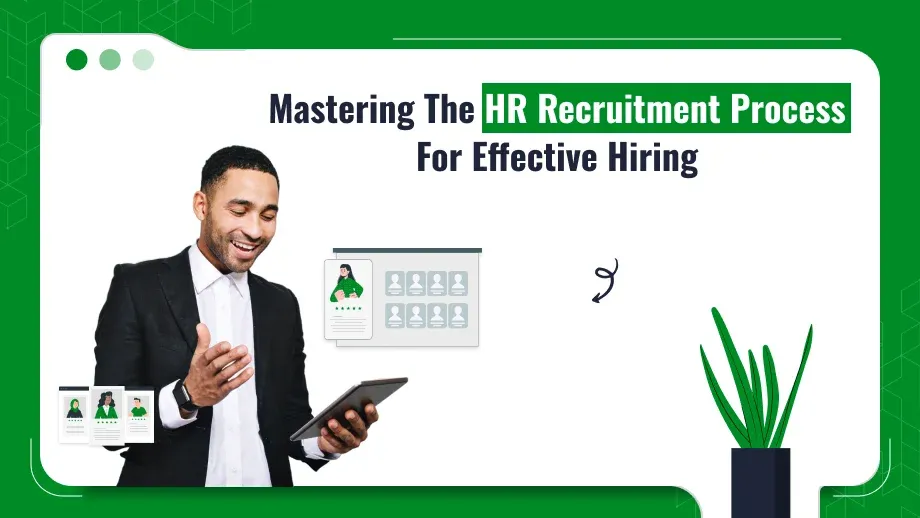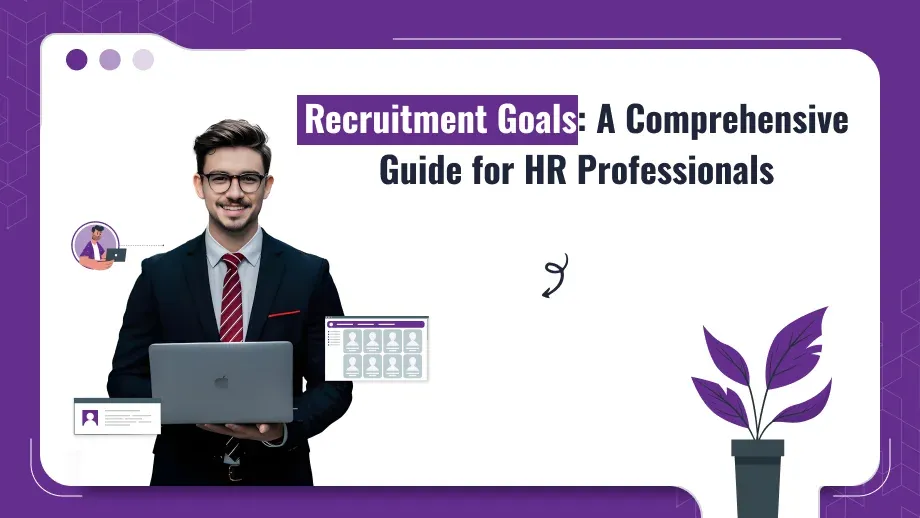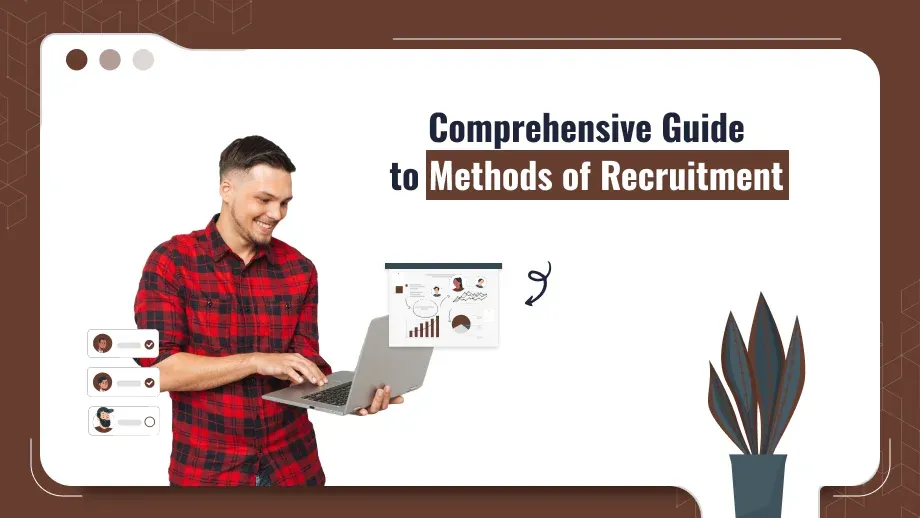
The HR recruitment process is the strategic journey of any organization in search of evaluating and hiring qualified candidates to open any position. Thus, it is not only filling up a vacancy but it establishes an excellent productive team to confirm organizational values and goals. There are explicit HR recruitment and selection processes that may help to reduce the time-to-hire, improve the quality of candidates, and prevent attrition of employees.
A structured approach, which may be described as talent attraction and long-term growth, is very beneficial for any organization, both in India and globally during the HR recruitment process. An understanding of the recruitment process in HR and the involvement of each step is important for every organization looking to stay competitive.
What Is The Recruitment Process In HR?
A step-by-step process for recruiting employees in the human resources function through which companies ensure that they attract and hire the most appropriate candidates for the job. Also known as the recruitment process steps in HR, this process entails all stages from determining staffing needs to an offer letter and training. The process of HR recruiter is designed to ensure a seamless fit between candidate skills and job requirements, thereby promoting both organizational growth and employee job satisfaction.
For instance, therefore, the hr recruitment process that an organization uses in India may demonstrate certain needs specific to its regional labor market. Such requirements would place unique talent sourcing and selection adaptations in that region, but regardless of the location, the basic steps of the core process of hr recruiter are important to every organization.
Key Steps in the HR Recruitment Process
Identifying Hiring Needs
Identifying roles that require filling will be the first step in HR recruitment. Knowing the specifics enables one to avoid unnecessary hiring and ensures that recruitment lines up with the long-term goals of the business. It involves talking to department managers on specifics, whether it is a new position or a replacement.
Creating a Detailed Job Description
A clear job description will be the foundation of a successful HR recruitment process. Companies detail the skills, experience, and cultural fit needed for an individual to meet the demands placed by the role, and thus, a clear job description can source the right candidates. The other most important benefit of clarity in job descriptions is that it improves the quality of applicants because it helps the candidate self-assess his suitability.
Sourcing Candidates
Candidate sourcing is a recruitment and selection process. Online job boards, referrals of employees, social media, and recruitment technology tools allow for an increase in talent pools. For example, LinkedIn and niche sites attract potential employees, both active and passive. Sourcing at a higher level allows companies to attract applicants from a very divergent range, thus thereby enhancing the inclusivity and access of varied skill sets.
Screening and Shortlisting
The screening process consists of scanning through resumes and applications to identify the people who qualify for the minimum requirements. Most firms today adopt the use of ATS for the mechanization and commodification of this screening process so that only those qualified individuals will advance to the next level. With an ATS, one can monitor the status of each candidate in the hiring pipeline and the critical recruitment statistics in HR, such as time-to-hire and source effectiveness.
Conducting Interviews
Interviews comprise the core part of assessing all dimensions of a candidate’s skills and experience and their fit into the company culture. Most organizations utilize a combination of interviews that include phone screenings, video interviews, and in-person assessments to gain a broad view of each applicant. Standardized interviews with standardized questions are argued, for the reason that they make sure there is consistency, fairness, and proper assessment within any organization’s process of recruitment by hr.
Extending Job Offers and Negotiation
After selecting the appropriate candidate, HR issues a formal job offer to the selected individual. That is also part of the human resource recruitment process which covers the bargaining about salary, benefits, and even the date on which the candidate will start his work. The explicit discussion in any mention of details about the offer will facilitate how the HR can clearly give expectations of that candidate and most likely facilitate cooperative engagement.
Onboarding and Training
An effective onboarding program will help establish a good foundation for bringing new employees into the organization effectively and successfully. It has been found to allow the employees to get familiarized with their roles, colleagues, and the culture in which their company operates. This process makes it the last stage of the recruitment process for Human Resources, onboarding being the engagement promoter that facilitates retaining employees while providing all the essentials needed in a company to ensure that the new employees are productive from the day they join.
Key Considerations When Creating a New HR Recruitment Process
Creating a constructive process for hr recruiters requires deep thinking and planning. Here are some key factors:
- Define Clear Objectives: Since clearly defined objectives such as time-to-hire are decreased, diversity improvement or candidate quality increases can create the proper alignment of the HR recruitment process with the help of organizational goals.
- Leverage Technology: Including the best HRMS Payroll Software in India and applicant tracking systems allows the maximum simplification of operations from sourcing to onboarding stages and provides invaluable data for the decision-making process.
- Governance Compliance: There are also labor laws and ethical standards that need to be complied with in each location, which further increases confidence while keeping away from legal issues.
- Candidate Experience: A positive, transparent HR recruitment process builds the company’s reputation and attracts top talent. Clear communication at every step keeps candidates informed and engaged.
- Evaluation Metrics: This allows measurable metrics such as time-to-hire, cost-per-hire, and applicant-to-hire ratio to be used to refine the process more based on real data. Recruitment reports are very helpful in identifying which strategy produces the best outcome.
Who Are the Role Players in the HR Recruitment Process?
The HR recruitment process involves multiple stakeholders working collaboratively:
- Hiring managers define the requirements of a job, interview the right candidates, and make recommendations for hiring.
- Recruiters: The recruiters do sourcing, screening, and initial interviews. They sieve them and forward such applicants to hiring managers.
- Interview Panels: Comprised of team members and stakeholders, interview panels help evaluate technical and cultural fit.
- HR Support Staff: Assist with scheduling, coordination, and maintaining compliance throughout the recruitment process.
- External Partners: Recruitment agencies and third-party vendors support by sourcing candidates and managing background checks, especially for specialized roles.
Best Practices for a Successful HR Recruitment Process
- Leverage Recruitment Technology: An applicant tracking systems and many other recruitment technology tools help reduce manual work and ensure that processes are carried out uniformly.
- Develop a Talent Pipeline: Engaging potential candidates regularly creates a reserve of talent, ready when roles open.
- Standardized Interviews: Standardized questions are asked in standardized interviews. Such interviews help ensure equal treatment of applicants while remaining fair in the whole selection process.
- Culture Fit: The closer the individual is to your current culture, the easier he/she will be to assimilate, and you are more likely to retain him/her over the long run.
Make sure your hiring process is optimized!
Simplify the HR recruitment process to attract and secure top talent quickly.
Challenges in the HR Recruitment Process and Solutions
Even with streamlined HR recruitment processes, companies continue to grapple with some challenging issues that help compromise hiring quality, timelines, and candidate satisfaction. This will enable an organization to build a larger and more efficient recruitment strategy if such problems are proactively managed. Here is a list of some common problems in the recruitment process and ways to overcome them.
Handling High Volumes of Applications Efficiently
With all these posting job openings, hundreds of thousands of applicants are placed before the companies. It becomes challenging to sort out the various applications within the given time frame, and quality applicants easily go unseen when not filtered by proper systems.
Solution: By putting up an applicant tracking system, one should be able to automatically screen the application based on keywords, experience, and qualifications. The applicant tracking system also tracks status and has real-time communication with the candidate and collaboration with hiring managers. Automated tools would save recruitment time for them to view only the best candidates.
Ensuring Diversity in the Candidate Pool
Diversity is very important in the development of a balanced team. However, it becomes tough to find diverse candidates since many fields are specialized. Traditional recruitment channels may also miss out on a diverse talent pool, which may make an inclusive workforce difficult to create.
Solution: Implement diversity diversity recruiting through the sourcing channels of expansion. Examples of such a strategy might include joint working with organizations that focus on diversity, attendance at career fairs in historically underrepresented universities, and language inclusive and inviting in job postings. Another example might be blind recruitment, where name, age, and gender are hidden in applications to minimize unconscious bias within the recruitment process and selection pool.
Reducing Time-to-Hire
A lengthy hiring process can be followed by the loss of good-quality candidates to competitors. Candidates today seek a fast and efficient recruitment experience and may disengage from the hiring timeline if it is drawn out too long.
Solution: Determine goals and timescales for each stage within the HR recruitment process, hence monitoring efficiency in the application of recruitment metrics in HR such as time-to-hire. Technology will come in handy to accelerate steps such as interview scheduling and uploading of documents by using recruitment technology tools or ATS. Also, using pre-assessment tests will accelerate candidate evaluations. The hiring manager will assess skills early and make swift decisions.
Maintaining Candidate Engagement and Reducing Drop-off Rates
Candidates lose interest if they are not updated about their application status or provided with speedy communication. Such disengagement may result in several drop-offs where applicants withdraw their applications before completion of the process.
Solution: Keep applicants engaged through clear, consistent communication. An applicant tracking system can automatically update each stage in the recruiting cycle, from acknowledgment that an application was received to providing feedback after interviews. Personalized messages to those not hired can enhance the candidate experience and boost their chances of applying again or referring the company to others.
Balancing Technical Skills with Cultural Fit
The complete challenge lies in the careful finding of candidates who possess technical skills along with compatibility with the culture of the company, bringing almost a delicate balance between both. Instead of focusing on the skills alone may end up yielding someone who does not gel properly with the team, while emphasizing too much on cultural fit would compromise the level of skill.
Solution: To deal with this, one can take recourse to formal interview processes that would aid in ascertaining a candidate’s technical competencies and behavioral competencies. Some of these behavioral interview questions may be utilized to probe into the value system, the way of working in teams, or their adaptability. Another alternative is to use various assessment tools, including personality tests and scenario-based activities, that will help gauge cultural fit without affecting necessary qualifications.
Retaining New Hires After Recruitment
Success in recruitment is ensuring talent attractiveness but also retaining talent. Higher turnover, particularly in recruits, can point to flaws in the recruitment process, such as over-optimistic job expectations or poor onboarding mechanisms.
Solution: Implement proper onboarding as part of the HR recruitment process. This will help newly hired employees familiarize themselves with their roles, understand team dynamics, and become part of the organization. Programs for mentorship and regular check-ins with clear expectations of their role can be a huge balancer for new hires when hired. The gathering of feedback from the recent hires about the recruitment and onboarding process will also help the organization improve the process.
Adapting to Remote Recruitment Challenges
Recruiting virtually presents its own set of issues because remote working is the new norm. For instance, when it comes to the issue of recruiting, virtual remoteness is highly prevalent, so how a candidate can work remoted becomes really tough to evaluate, and developing rapport through virtual channels also becomes challenging.
Solution: Use the recruiting process of HR specifically for remote settings to introduce tools related to virtual assessment and scenario-based tasks that would give a measure of the “remote skills” of work, such as which could relate to communication, self-discipline, and management of time. To make the candidates feel at ease, video introduction, virtual office tour, and guidelines for remote onboarding can create an appealing environment.
Adhering to Legal and Compliance Standards
It is not easy to make your way through the legal requirements, much so about the hr recruitment process in India, especially in countries like India and their counterparts that have very strict labor laws. Failure to observe such standards of compliance may attract costly penalties along with reputational damage to the organization.
Solution: The recruitment policies should be reviewed and updated from time to time to ensure all conformity with employment acts and legislation. Using HRMS Payroll Software India can assist in maintaining compliance records, and data about employment securely saved and generating all such documentation required. The recruitment practices must be alike with data protection and equal opportunity laws to ensure fairness and transparency in the recruitment process.
Accurately Assessing Candidate Potential
That is, the real value of a candidate cannot be determined based solely on a resume and interviews, and thus the most beneficial long-term hires are impossible to determine. Traditional hiring often misses out on potentially able candidates with formal experience in adequate capabilities.
Solution: Talent mapping software and skill assessment tools may be used to evaluate a candidate’s growth potential, adaptability, and problem-solving abilities. Task-based assessments or small project assignments may be implemented for those technical skills positions that require specific technical skills. These will reflect the practical skills and potential through which a recruiter could make informed hiring decisions.
Managing Costs in the Recruitment Process
Recruitment costs associated with advertising, agency fees, and time consumed can mushroom well beyond expectations, impacting bottom-line profitability. Furthermore, organizations interested in high-volume hiring-or indeed in any area where quality meets cost-faced the dilemma of achieving both.
Solution: By analyzing a recruitment process report, the costs incurred and areas that can be optimized to save funds can be determined. Cost-saving strategies may include hiring through company employee referrals, advertising the job opportunities to hit the ideal target, and reducing dependency on expensive external recruiters for hiring. The business continually assesses its spending and makes adjustments needed to align it with the budget while maintaining high quality by making use of HR tracking of recruitment metrics.
Measuring Success in the HR Recruitment Process
Measures of critical recruitment metrics in HR, such as time-to-hire, cost-per-hire, and quality of hire, quantify the recruitment process. Consistently producing reports on the recruitment process based on data provided by the ATS offers insight into every step in the HR recruitment process, clearly articulating strengths and weaknesses.
HR Recruitment Process vs. Talent Acquisition
The traditional recruitment process is goal-oriented and directed toward fulfilling an existing gap or near-term requirement. Talent acquisition is a much broader, long-term approach that should fill a continuous pipeline of professionals with specific skills, targeted at the organization’s future business goals.
Creating an Ongoing Recruitment Strategy
An effective recruitment strategy extends way beyond the immediate hiring needs of an organization by predicting and providing future pipeline needs. The three things through which this can be made possible in the case of a recruitment process are managing a positive employer brand, networking with future employees, and relationship-building with industry groups to realize an appropriate pipeline.
The Role of Candidate Experience in the HR Recruitment Process
The candidate experience is one of the imperative elements connected with recruitment, particularly in HR. Communication with candidates must be straightforward; there should be swift feedback, and proper engagement should always be individualized. The positive candidate experience at any point in the process builds the company’s brand and attracts quality talent.
Conclusion
A well-designed HR recruitment process builds organizational capacity and aids growth. Defining steps, involving technology, and embracing best practices result in organizations recruiting the best workforce to remain fit for today and its future challenges. Progression tracking, also improving itself on recruitment metrics, in HR creates robustness toward long-term goals. In this regard, an effective flexible recruitment process becomes a necessity for sustaining success in this changing hiring landscape.






